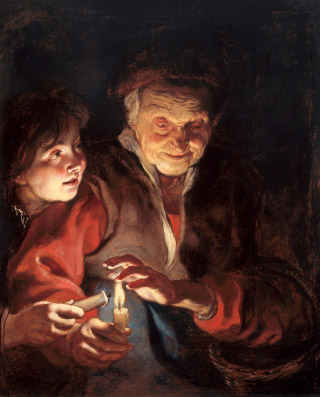
The Dark Side of Light
TENEBRISM: from the Italian, tenebroso (murky) – a style of chiarpscuro painting using violent contrasts of light and dark, where darkness becomes a dominating feature of the image. –Art Definitions
And God said, ‘Let there be light,’ and there was light. God saw that the light was good, and he separated the light from the darkness. -Genesis
Impossible to hold, elusive as hope, light is the stuff of life some find at the end of death’s tunnel.
We call it: Healing, Transcendent, Radiant, Faithful.
We call it: Cool, Cold, Glittering, Golden, Red-Hot.
We call it: Blinding, Searing, Fierce, Exposing, Ghastly, Glowing, Faint, and Fading.
Artists call it: Necessary. And Malleable.
The painters of 17th century Europe studied in depth the unique drama of heavy shadow contrasted with a single source of radiant light.
Nix  that word “unique.” Replace it with “ubiquitous.”
that word “unique.” Replace it with “ubiquitous.”
If artists paint what they know chiaroscuro was what the night looked like. For most of the world it still is.
Fires, torches, lamps and tallows, in countryside and city centers people gathered together around that light. The only other option was the moon. Even in Provincetown.
At the turn of the 20th century the famous, reflective light of Provincetown drew such a pilgrimage of artists that they changed the demographics of the town.
They came just a little after people began lighting up their interiors and exteriors with electricity, and now the party-by-night town battles back the dark with a flood of incandescence, colored neon and the chilling LED.
A few months ago at the Rice Polak Gallery, Steven Skollar, a painter who has mastered the Tenebrismic theme, exhibited a new body of work. You can taste the richness of Skollar’s color-drenched surfaces pulling forth from blackest shadows. Though he bows with respect to the masters of the past, as an artist of the here-and-now Skollar made the leap into our light, of which no artist of the past could have conceived.
In this recent work he took the classic effect of faces lit by the light of a single candle and replaced it with the x-ray glow of a cellphone.
Historical logic? Aesthetic curiosity? Or is it wordless social commentary?
Soon enough the humorous conceit behind the sheer beauty of his portraits grew troubling. I forgot that light can be sinister.

The illumination Skollar captured is our new “ubiquitous.” We all recognize that futuristic, radioactive glow. On every street, every subway, every beach, our faces reflect a new, Sci-Fi, chiaroscuro’d light gathered around by no one but ourselves.
It is a convenient light, but there is sorrow and danger in it.
For example:
Clustered in the vast, sand-swept National Seashore are a handful of old dune shacks. Those who get the chance to spend time in one seek the atavistic limitations they impose, including the lush shadows and warm, focused light cast by a few kerosene lamps after sundown.
But now most of us pack along our cellphones – compulsively, guiltily, as if they were cigarettes.
On our last night in one of the shacks something went wrong with my phone’s email. We spent our evening’s hours bent over its problems. Afterwards I looked up and realized both of us were staring silently at our phones, neither looking at nor talking to each other, our features trapped in their kryptonite ray.
All around us was our last chance to take in the dune shack’s rare spirit, its beams and dark old wood and red painted door and moonlit porch. But, like flies in a web, we opted for the tenebrism of our illuminating cellphones.
We realized at once, and with regret, we were the very likeness of a Steven Skollar painting. Light: The new darkness.



